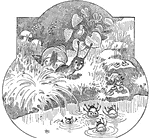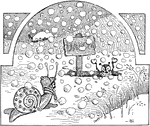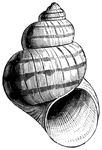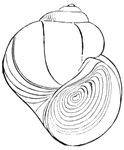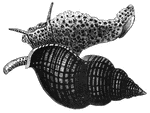
Snail
A gasteropodous mollusk, differing from the slug in having a large, spiral shell. The species are very…

Snail
Diagram of the mouth of a snail, showing the lingual ribbon. br, brain; c, buccal cavity; co., caelom;…

Snail
Diagram of a dissection of the reproductive organs of a snail. a.g., albumen gland; c.d., common or…

Snail Anatomy
"Anatomy of the Snail: a, the mouth; bb, foot; c, anus; dd, lung; e, stomach, covered above by the salivary…
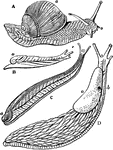
Snail and Slug
A series of Stylommatophorous Pulmonata, showing transitional forms between snail and slug.
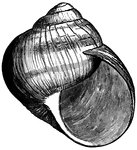
Roman Snail Shell
Helix pomatia. "A large-shelled, edible" snail, also called the Burgundy snail or escargot when used…
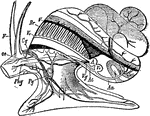
Circulatory and Nervous System of a Snail
Circulatory and nervous system of a snail. Labels: F, tentacles; Oe, esophagus; Cg, cerebral ganglion;…
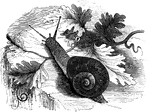
Common snail
"This is furnished with four tentacula, two of which are smaller than the others; at the end of these,…

Northern Moon Snail
Lunatia heros or the Northern moon snail, the common salt-water snail of the Atlantic coast.

Violet Snail
The violet snail is a floating sea slug. The snail is able to float due to the mucus covered raft that…
Snailfish
Liparis lineata. A fish of the genus Liparis; so called from their soft unctuous feel, and their habit…

Snailfish - Sucker Between the Pectoral Fins
Liparis lineata. A fish of the genus Liparis; so called from their soft unctuous feel, and their habit…
!["The Angel-winged is shown [here]. It is veined with stripes of white and red, and comes from the coasts of Asia and America."](https://etc.usf.edu/clipart/51600/51610/51610_strom_gallus_mth.gif)
Strombus Gallus (Linn.)
"The Angel-winged is shown [here]. It is veined with stripes of white and red, and comes from the coasts…
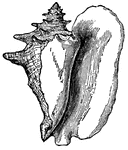
Shell of Strombus Gigas
"The Strombus is a peculiar genus, belonging to the equatorial seas. Some of these attain great…

Strombus Gigas (Linnaeus), with the animal
"The Strombus is a peculiar genus, belonging to the equatorial seas. Some of these attain great…

Triton Anus (Lamarck)
"The genus Triton is classed next to the genus Murex. The shell is irregularly covered…

Voluta Cymbium (Linnaeus)
"The Volutes live in the sands near the shore; sometimes they are found high and dry, left by the retreating…

Voluta Delessertii (Petit)
"The Volutes live in the sands near the shore; sometimes they are found high and dry, left by the retreating…

Voluta Imperialis (Lamarck)
"The Volutes live in the sands near the shore; sometimes they are found high and dry, left by the retreating…

Voluta Musica (Linn.)
"The Volutes live in the sands near the shore; sometimes they are found high and dry, left by the retreating…

Voluta Scapha (Gmel.)
"The Volutes live in the sands near the shore; sometimes they are found high and dry, left by the retreating…

Voluta Undulata (Lamarck)
"The Volutes live in the sands near the shore; sometimes they are found high and dry, left by the retreating…

Voluta Vexillum (Chem.)
"The Volutes live in the sands near the shore; sometimes they are found high and dry, left by the retreating…

Wentletrap
The wentletrap (Scalaria pretiosa) is gastropod mollusk named after its spiral staircase appearance.

Wentletrap
The wentletrap (Scalaria pretiosa) is gastropod mollusk named after its spiral staircase appearance.
